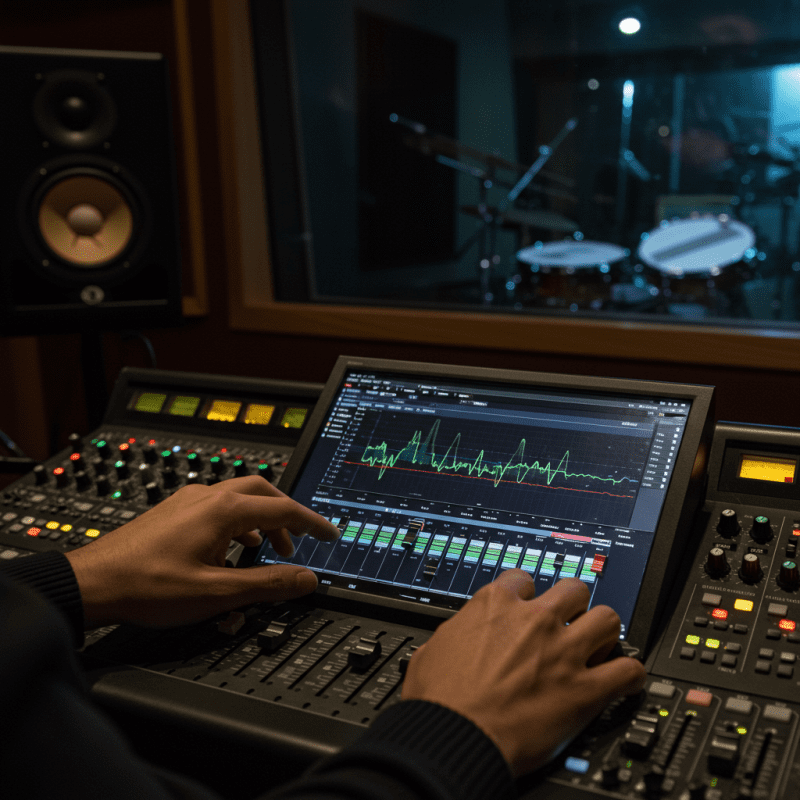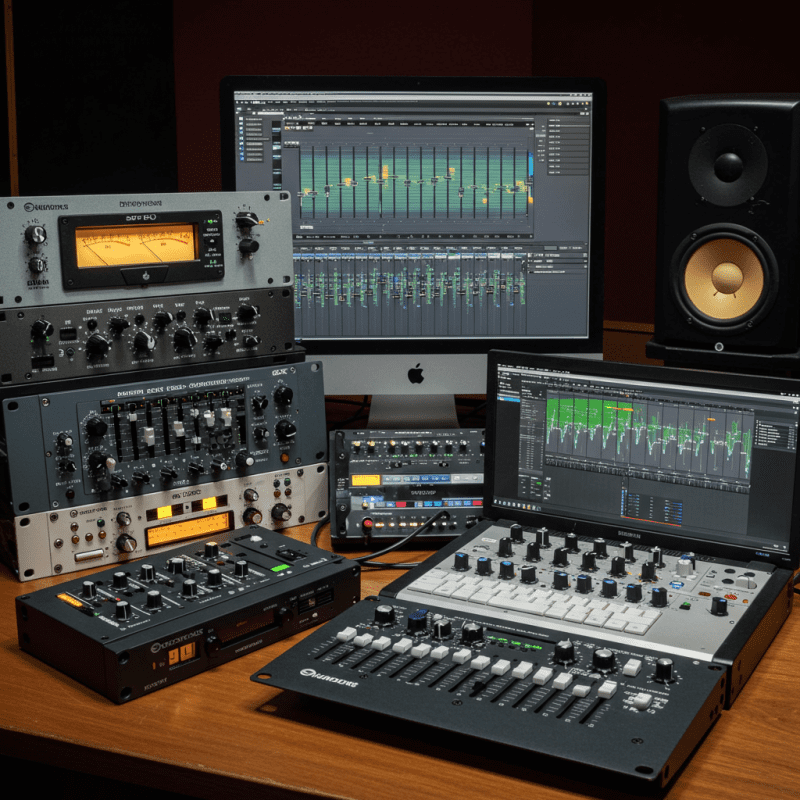This post may contain affiliate links which means we may receive a commission for purchases made through links. Learn more
So, you’ve recorded your drums and they sound… okay. But they’re not quite hitting you in the chest or cutting through the mix like you want them to. Don’t worry, that’s totally normal! This is where EQ, or equalization, comes in to save the day. It’s the magic trick that turns a good drum recording into an awesome Professional sounding one!
This guide is all about giving you the essentials for drum EQ. We’ll go through your kick, snare, and toms one by one to show you how to fix problems like mud and ring, and then how to make everything pop with punch and clarity. It’s easier than you think!

The Philosophy of Drum EQ: Cutting First, Boosting Later
Think of EQ like cleaning up a room before you decorate it. You wouldn’t want to bring in a bunch of new furniture when the floor is a mess, right? The same goes for your sound.
- Subtractive EQ: This is all about cleaning up. You’ll want to cut or remove the bad stuff first—like annoying ringing noises or a general murky sound. A great trick is to find those nasty frequencies with a tight EQ boost and then cut them out. It’s like finding a dirty spot on the floor and sweeping it away!
- Additive EQ: This is the fun part! Once your sound is clean, you can start to boost the good frequencies to make your drums sound even better. Maybe you want more punch from your kick or more crack from your snare. Just remember, a little boost goes a long way.
The best way to do drum EQ is to clean up the sound first with cuts, and then add a little sparkle with boosts!
Kick Drum EQ: The Heartbeat of Your Song
The kick is the most important part of your rhythm section. It’s what people feel in their chest! Our goal with drum EQ here is to give it power and definition without making it a big, boomy blob of sound.
Key Frequencies to Target
- Sub-Bass (30-60 Hz): This is the super-low rumble you feel, not just hear. A little boost here can give your track some serious weight, but don’t go crazy or it will just get messy on small speakers. Don’t forget a high-pass filter to clean up anything below 30 Hz.
- Body and Thump (60-150 Hz): This is the core “thump” that gives your kick its power. Find the sweet spot in this range to give your kick that perfect chest-punching sound.
- Attack and Beater Click (2-5 kHz): This is the sound of the beater hitting the drum head. A small boost here helps your kick stand out in a busy mix, especially for rock or metal. But be careful it doesn’t sound too clicky!
Cutting Problem Frequencies
- Boxiness (300-600 Hz): Does your kick sound like it’s in a cardboard box? Yikes! This is the frequency range to clean up with a broad cut. It’ll make your kick sound much more open.
- Low-Mid Muddiness (150-300 Hz): If your kick and bass are fighting each other for space, a cut here can make everything sound clearer and more defined.
Snare Drum EQ: The Life of the Party!

The snare is the personality of your drum kit. It needs to have a crisp attack and a powerful body to really drive the beat. Good snare drum EQ is all about getting that perfect balance.
Key Frequencies to Target
- Body and Fatness (150-250 Hz): This is where you get the “thump” and power of the snare. A small boost here makes it sound nice and fat.
- Attack and Snap (1-5 kHz): This is the sound of the stick hitting the skin. It’s what makes the snare “crack.” Boosting in this range, maybe around 2-4 kHz, will give it that sharp snap you’re looking for!
- Sizzle and Ring (5-10 kHz): This is the sound of the snare wires. You can add a little sparkle with a gentle high-shelf boost, but watch out for harshness.
Cutting Problem Frequencies
- Boxiness (400-800 Hz): Again with the boxiness! This range can make your snare sound hollow. A wide cut here will help a lot.
- Ringing Overtones (300-800 Hz): Snare drums love to ring in weird, annoying ways. Just sweep a tight boost around this area to find that ringing sound, then cut it out with a deep, narrow cut. It works like magic!
Tom EQ: Adding Depth and Fill
Toms are all about those awesome fills. They need to sound full and punchy, but they also have a habit of ringing just like the snare. Our tom drum EQ mission is to make them sound great without those distracting tones.
Key Frequencies to Target
- Body and Resonance (80-250 Hz): This is where the core tone of the tom lives. A floor tom will be lower in this range, while a rack tom will be a bit higher. Find the sweet spot to get that full, resonant sound.
- Attack and Stick Impact (2-6 kHz): To make your toms sound like they’re really part of the performance, give a little boost to the attack. This brings out the “thwack” of the stick hitting the drum head.
Cutting Problem Frequencies
- Ringing and Overtones (300-800 Hz): Toms are famous for their ringing tones. Just like with the snare, find the offensive frequency by sweeping with a tight boost and then make a deep cut to get rid of it. You might need to do this for a couple of different spots.
- Low-End Rumble (Below 80 Hz): A high-pass filter is your best friend here! You can remove a lot of unnecessary low-end rumble that just clutters up your mix, especially from the smaller toms.
A Holistic Approach: Putting It All Together!

Remember, you’re not mixing a bunch of individual drums—you’re mixing a whole kit! It’s all about making the kick, snare, and toms work as one.
Here are a few final tips:
- Create Space: If your kick and bass are clashing, try a small cut in the same frequency range on one of them. This gives each instrument its own space to breathe!
- Filter, Filter, Filter: Don’t be afraid to use high-pass filters on almost every drum track. You’d be surprised how much clearer your mix will sound.
- Trust Your Ears: These are just suggestions to get you started! Every drum kit and every song is different. Just listen closely and make adjustments based on what feels right to you.
You’ve got this! With a little practice, you’ll be a master of drum eq in no time and your tracks will sound amazing.


